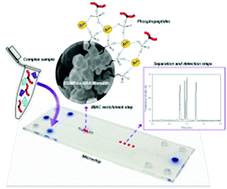A lab-on-a-chip for monolith-based preconcentration and electrophoresis separation of phosphopeptides
Abstract
A microdevice combining online preconcentration and separation of phosphopeptides was developed in a glass microchip. An ethylene glycol methacrylate phosphate (EGMP), acrylamide (AM) and bisacrylamide (BAA) based monolith was synthesized within microchannels through a photo-driven process. Morphological investigations revealed a homogeneous monolithic structure composed of uniform nodules (∼0.8 μm), with a large pore volume (0.62 cm3 g−1) and sufficiently high specific surface area (34.1 m2 g−1). These features make the monolith particularly interesting for preconcentration purposes. Immobilization of Zr4+ ions on the phosphate groups present at the poly(EGMP-co-AM-co-BAA) monolith surface leads to immobilized metal affinity chromatography support. This monolith-Zr4+ showed a great capacity to capture phosphopeptides. Successful preconcentration and separation of a mixture of ERK2 derived peptides differing only by their phosphorylation degree and sites could be achieved with signal enhancement factors between 340 and 910 after only 7 min of preconcentration. This integrated microdevice represents a novel approach for phosphoproteomic applications.



 Please wait while we load your content...
Please wait while we load your content...